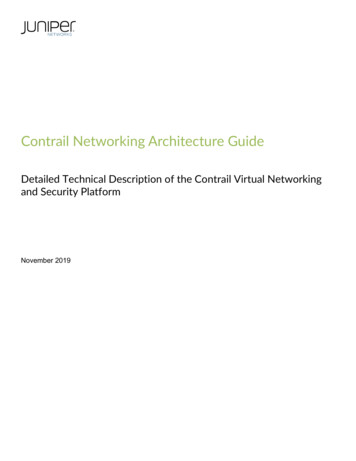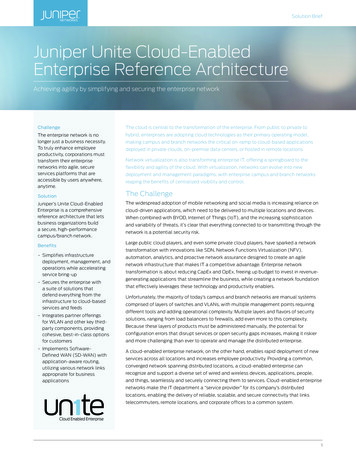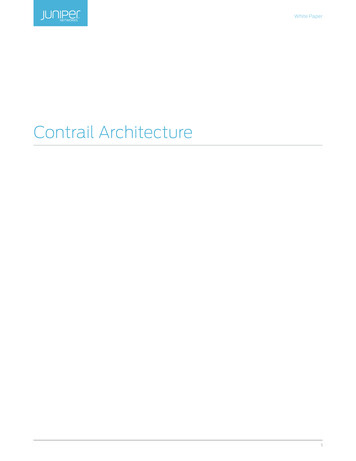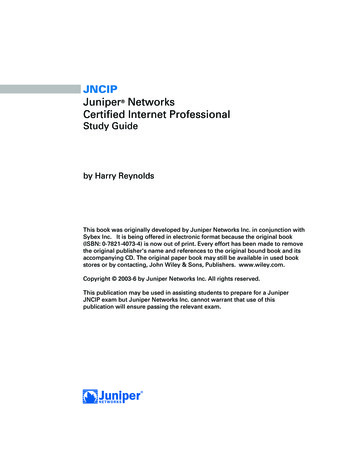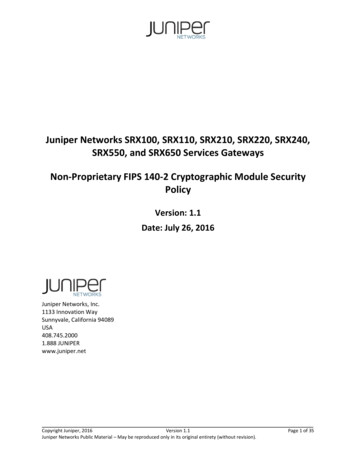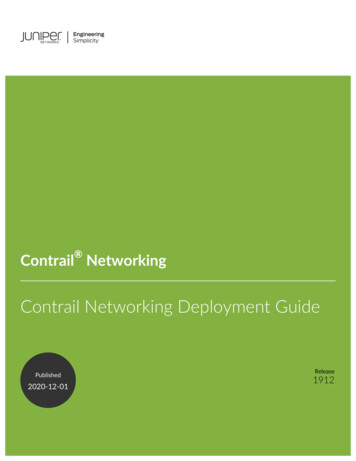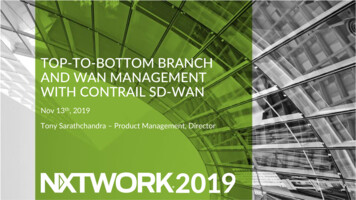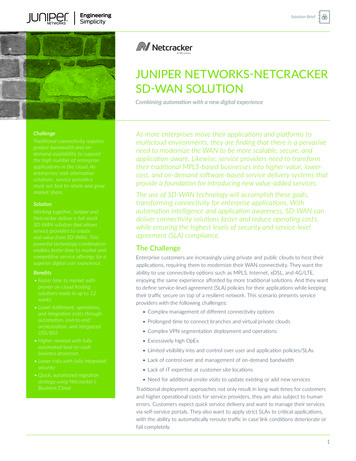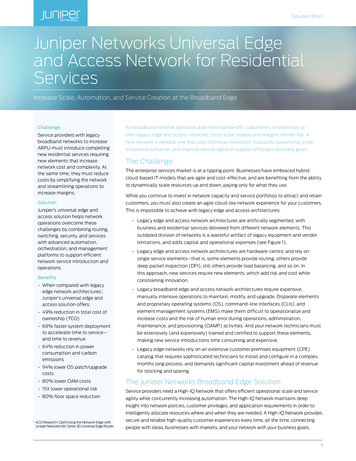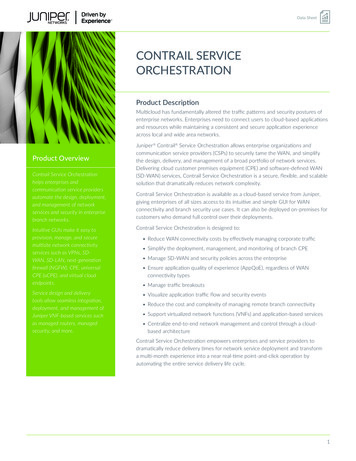
Transcription
Data SheetCONTRAIL SERVICEORCHESTRATIONProduct DescriptionMulticloud has fundamentally altered the traffic patterns and security postures ofenterprise networks. Enterprises need to connect users to cloud-based applicationsand resources while maintaining a consistent and secure application experienceacross local and wide area networks.Product OverviewContrail Service Orchestrationhelps enterprises andcommunication service providersautomate the design, deployment,and management of networkservices and security in enterprisebranch networks.Intuitive GUIs make it easy toprovision, manage, and securemultisite network connectivityservices such as VPNs, SDWAN, SD-LAN, next-generationfirewall (NGFW), CPE, universalCPE (uCPE), and virtual cloudendpoints.Service design and deliverytools allow seamless integration,deployment, and management ofJuniper VNF-based services suchas managed routers, managedsecurity, and more.Juniper Contrail Service Orchestration allows enterprise organizations andcommunication service providers (CSPs) to securely tame the WAN, and simplifythe design, delivery, and management of a broad portfolio of network services.Delivering cloud customer premises equipment (CPE) and software-defined WAN(SD-WAN) services, Contrail Service Orchestration is a secure, flexible, and scalablesolution that dramatically reduces network complexity.Contrail Service Orchestration is available as a cloud-based service from Juniper,giving enterprises of all sizes access to its intuitive and simple GUI for WANconnectivity and branch security use cases. It can also be deployed on-premises forcustomers who demand full control over their deployments.Contrail Service Orchestration is designed to: Reduce WAN connectivity costs by effectively managing corporate traffic Simplify the deployment, management, and monitoring of branch CPE Manage SD-WAN and security policies across the enterprise Ensure application quality of experience (AppQoE), regardless of WANconnectivity types Manage traffic breakouts Visualize application traffic flow and security events Reduce the cost and complexity of managing remote branch connectivity Support virtualized network functions (VNFs) and application-based services Centralize end-to-end network management and control through a cloudbased architectureContrail Service Orchestration empowers enterprises and service providers todramatically reduce delivery times for network service deployment and transforma multi-month experience into a near real-time point-and-click operation byautomating the entire service delivery life cycle.1
Contrail Service OrchestrationContrail ServiceOrchestrationBranch / RemoteOfficeCampus / HQ4G/LTEWAN s,4G/LTELegacy andxDSLAccessWirelessAccessDCISaaS Public WANBroadbandInternetData Centers /Private CloudPrivate / Public WANPublic CloudWireless AccessFigure 1: Contrail Service Orchestration manages SD-WAN routing and end-to-end security.Architecture and Use CasesSD-WANContrail Service Orchestration offers a flexible and automatedway to connect enterprise locations to each other, as well asto the Internet and multicloud, including Amazon Web Services(AWS) VPC. The SD-WAN deployment model supports JuniperNetworks SRX Series Services Gateways and Juniper NetworksNFX Series Network Services Platforms as CPE devices, whichare located on the customer premises to securely connectLAN segments to the WAN. The SD-WAN Essentials usecase is a perfect fit for small enterprises looking for simplifiedmanagement and comprehensive NGFW security services at thebranch sites. Internet traffic can breakout locally avoiding theneed to backhaul web traffic over costly VPN or MPLS links. TheSD-WAN Advanced use case is intended for larger enterpriseswith one or more data centers requiring policy-based dynamicapplication steering and flexible connectivity topologies. Siteto-site connectivity can be established using a hub in a huband-spoke topology or through static or dynamic full mesh VPNtunnels. Contrail Service Orchestration uses enterprise-wideintent-based SD-WAN policies and service-level agreement(SLA) measurements to differentiate and dynamically routetraffic for different applications.NGFW ManagementContrail Service Orchestration offers next-generation firewall(NGFW) management capabilities in the branch with the SRXSeries Service Gateways, Juniper Networks vSRX Virtual Firewallrunning on the NFX Series platform, or standalone vSRXVirtual Firewall running in a cloud footprint. Contrail ServiceOrchestration enables large enterprises and CSPs to create,deploy, and manage intent-based NGFW services from the cloud.Key FeaturesAutomated Network Orchestration and Control: ContrailService Orchestration simplifies branch management, deliveringgreater network flexibility and agility through dynamic andautomated workflows. Zero-touch deployment (ZTD), zerotouch provisioning (ZTP), and configuration templates greatlysimplify branch network turnup and connectivity. Subsequentservice updates and policy changes are consistently anddynamically inserted into the existing device, resulting inoperational efficiency for service providers and enterprisecustomers alike by limiting or in some cases eliminating serviceinterruptions and business disruptions. Additionally, it supportsVNF management.Application SLA Policy Management and Routing: Policybased application routing automates application and resourceprovisioning across multiple network connections and paths. Itsupports more than 4000 application signatures; applicationsare routed dynamically across multiple network connections tomeet user-specified SLAs.2
Contrail Service OrchestrationVNF Management: The Network Service Designer tool, acomponent of the on-premises version of Contrail ServiceOrchestration, supports end-to-end life-cycle managementfor VNFs. The Network Service Designer GUI allows productmanagers and network engineers to design, create, manage,and configure VNF-based network service templates. VNFs canbe more easily provisioned and service chained on the CPE.Contrail Service Orchestration supports both Juniper and thirdparty VNFs.Integrated Security: Contrail Service Orchestration is integratedwith the SRX Series gateways and the vSRX Virtual Firewall,high-performance NGFWs that provide advanced securitycapabilities such as unified threat management (UTM) andNetwork Address Translation (NAT). The Contrail ServiceOrchestration administration portals also support securitymanagement and reporting.Fully Redundant Platform: Contrail Service Orchestration is afully redundant platform. It supports both redundant and nonredundant installation options, as well as spoke redundancy, hubsite redundancy through its support for multihoming, and highcontroller availability.Multitenant Support: Contrail Service Orchestration supportsmultiple tenants, allowing CSPs to serve and manage multiplecustomers with one instance. Multitenant support simplifiesthe management of multiple WANs, LANs, uCPE, and NGFWfor service providers, and it reduces the complexity ofmanaging multiple sites and departments for IT managers atlarge enterprises. Contrail Service Orchestration’s multitenantcapability offers the CSP or enterprise IT manager a singleNetwork Service Designer and administration portal whiledelivering secure segmentation to end users. End users havetheir own separate WAN, LAN, uCPE, and NGFW that can beconfigured, secured, monitored, and managed to meet theirunique business requirements.management for enterprise IT organizations and CSP networkengineering, operations, and product management teams.The portals support role-based access control, giving networkadministrators full access to the tools and resources needed todesign, deploy, manage, and monitor network services whileproviding limited access to other users.The Network Service Orchestrator integrates with existingoperations/business support systems (OSS/BSS) through itsnorthbound REST API and also offers multitenant customerportals, pushing user-defined policies southbound to the NetworkService Controller that manages the required network devices.The Network Service Orchestrator consists of the followingportals:Network Service Designer: The Network Service Designerprovides product managers and network architects with anintuitive point-and-click solution for performing the servicedefinition that is part of service life-cycle management for bothJuniper and third-party VNFs. An easy step-by-step servicedesign implementation wizard walks you through the servicedefinition process, specifying the VNF onboarding process, VNFversion control, VNF description, and more. The Network ServiceDesigner also assists with service configuration parameters,service chaining templates, and customer-specific service catalogsthat get exposed through the customer portal. The entire servicedefinition is saved in a database via standard YANG data models,providing easy integration with third-party operations supportsystems (OSS) and business support systems (BSS). This tool isonly available as an on-premises solution and not as a cloudbased CSO SaaS.Key ComponentsContrail Service Orchestration includes the followingcomponents:Network Service OrchestratorThe Network Service Orchestrator is the interface to ContrailService Orchestration. Its portfolio of GUI-based design,integration, and management tools enables the onboardingand integration of VNFs, supports the design and managementof network services such as SD-WAN, and provides statusmonitoring and analytics.Contrail Service Orchestration GUI portals automate networkand service design, deployment, monitoring, management,security, and reporting, reducing the complexity of networkFigure 2: Contrail Service Orchestration Network Service DesignerAdministration Portal: The Administration Portal gives networkadministrators simultaneous visibility into customers’ onpremises and hybrid cloud-based services, enabling them toeasily monitor and troubleshoot service health and status.Detailed service information is readily accessible for monitoringvirtual or physical CPE, SLAs, CPE resource diagnostic reports,service catalog resources, and other administrative functions.3
Contrail Service OrchestrationThe Administration Portal supports role-based access control(RBAC), as well as both local authentication and SecurityAssertion Markup Language (SAML)-based authentication forsingle sign-on (SSO). Administrators can also create more userswith specific roles and access privileges.Figure 4: Contrail Service Orchestration Customer PortalFigure 3: Contrail Service Orchestration Administration PortalMultitenant Customer Portal: The Customer Portal is providedthrough a unified portal with access to functions governed by anRBAC to fill a per-tenant admin and tenant operator role (readonly access). Tenants, such as service provider customers, havethe freedom to self-select the services that best fit their businessneeds. The portal can be customized by the service provideror the enterprise owner/operator to align with their corporatebrand and identity. They can also select the appropriate servicedeployment model on-premises or in the cloud, with the flexibilityto determine when to deploy, change, or delete a service in nearreal time. Service providers can choose to develop their owncustomer portal GUI using REST APIs.Security Management: Contrail Service Orchestration includesthe ability, through the same management platform, toorchestrate managed security services as part of the suite ofnetwork services. You can manage NAT policy or intent-basedfirewall policy to ensure security across Layer 4 transport rulesthrough Layer 7 application rules. Policy automation allows forconsistent and easy deployment across the network. Integratedsecurity dashboards and alerts provide visibility into which sitesare secure. With security management built in, pervasive andalways-on security is part of every deployment.Figure 5: Integrated secure SD-WAN4
Contrail Service OrchestrationNetwork Service ControllerThe Network Service Controller provides life-cycle managementof VNFs deployed by Contrail Service Orchestration. It includesthe virtualized infrastructure manager (VIM), Network FunctionsVirtualization Infrastructure (NFVI), and device managementfor supported CPE endpoints, including deployment, activation,scaling, updating, and terminating VNFs. It also manages servicechains on the CPE endpoint, as well as the chaining of end usersto services located in the cloud.In SD-WAN deployments, the Network Service Controllerbecomes the SD-WAN controller, simplifying networkprovisioning, supporting multiple network topologyarchitectures, and executing network control and managementcapabilities. As an SD-WAN controller, it manages key activitiessuch as configuration, ZTP, installing updates, pushing newpolicies onto CPE devices and network-based hub gateways,maintaining network connections, and gathering applicationperformance and network and device telemetry data.Policy ManagerContrail Service Orchestration’s Policy Manager providesintuitive policy management capabilities across enterprise andspecific sites for WAN, LAN, and security services. The policymanager abstracts complex policy management, providing asimple and intuitive user interface.Figure 6: SD-WAN policy management screens5
Contrail Service OrchestrationContrail AnalyticsDrive User Experience with Mist WAN AssuranceThe Contrail Analytics component is a scalable data managementsystem that supports large numbers of tenants, devices, andservices data. Contrail Analytics also supports a number ofContrail Service Orchestration system capabilities, includingdevice and service status, real-time service performance, andalert and notification for overall system maintenance.Mist WAN Assurance is a cloud-based service that brings AIpowered automation and service levels to SRX Series ServicesGateways, complementing the Juniper Secure SD-WANsolution. Mist WAN Assurance transforms IT operations fromreactive troubleshooting to proactive remediation, turninginsights into actions and delivering operational simplicitythrough seamless integration into existing deployments.This system collects and analyzes the large amounts of datarequired for SD-WAN and security use cases. The data alsosupports visualization and monitoring of services acrossWAN and security, as well as historic time series data for pastperformance and reporting. SRX Series firewalls, deployed as secure SD-WANedge devices, provide the rich Junos operating systemstreaming telemetry that provides the insights needed forWAN health metrics and anomaly detection. This data is leveraged within the Mist Cloud and AI engine,driving simpler operations, reducing mean time to repair,and providing better visibility into end-user experiences. Insights derived from SRX Series SD-WAN gatewaytelemetry data allows Mist WAN Assurance to computeunique “user minutes” that indicate whether users arehaving a good experience.Figure 7: Detailed analytics viewsReports and Audit LogsContrail Service Orchestration features a built-in reportingcapability to generate WAN, security, and audit log reports.Users can schedule reports at predefined intervals or generatecustom reports on demand.Figure 8: Reporting views6
Contrail Service OrchestrationContrail Service Orchestration Features and BenefitsFeaturesBenefitsAvailable as a cloud-managedservice from Juniper or in onpremises deployment modeContrail Service Orchestration is offered as a cloud-managed centralized management service from Juniper, reducing capital andoperational expenses for large enterprises and CSPs. It can also be deployed on-premises for enterprises and CSPs that want fullcontrol.Supports multiple CPE platformsNFX Series Network Services Platforms allow you to design, develop, and deliver a portfolio of managed services from oneorchestration solution. Contrail Service Orchestration and the NFX Series support a number of Juniper and third-party VNFsolutions, and Juniper Professional Services can help customers integrate additional VNFs as needed.SRX Series Services Gateways let you easily deploy a high-performance, orchestrated, and fully automated NGFW-based managedsecurity solution from a centralized management platform.Supports zero-touch provisioning(ZTP)Supports zero-touch provisioning (ZTP)Contrail Service Orchestration delivers a fully automated deployment experience forsupported CPE. Simply take the supported CPE out of the box, connect it to the network, and power up. The supported CPE willcall home, download any required software and configuration updates, install them, and begin delivering the provisioned services,reducing operational expenses and demands on IT staff.Offers flexible deployment optionsSupported topologies: Hub-and-spoke, dynamic mesh, and partial mesh topologies are supported, providing flexibility across service provider andenterprise environments.– In the hub-and-spoke model, corporate locations or network-based routers or firewalls can be identified as hub gateways,providing network management and control.– In the dynamic mesh topology, each endpoint connects to every other endpoint device based on CPE settings by admins.– In the partial mesh topology, clusters of CPE can be set up for dynamic mesh while gateway/hub mesh enable intra-meshtraffic.Supported architectures: Supports multiple hub gatewaydevicesSD-WAN and AWS spoke endpoints are supported for tenants with multiple site types. On-premises spoke gateways: SRX Series devices can be used as premises-based gateway devices in hub-and-spoke anddynamic mesh topologies, letting enterprises access data center applications directly via the gateway. Cloud- or network-based hub gateways: SRX Series gateways can be used as multitenant service provider cloud-basedhub devices. vSRX Virtual Firewall: The vSRX can be used as an SD-WAN hub, providing greater agility and versatility for supportingplatforms that can be used as endpoint devices both on premises and in the cloud.Supports multiple WAN link typesContrail Service Orchestration supports five different WAN link types with high bandwidth and low latency: MPLS over copper and fiber Ethernet broadband Asymmetric digital subscriber line/ very-high-bit-rate digital subscriber line (ADSL/VDSL) LTE Satellite links with very low latencyOffers native MPLS supportContrail Service Orchestration natively supports MPLS for integration into IP-VPN network.Ensures application quality ofexperience (AppQoE)Advanced policy-based routing (APBR): Traffic flows can be classified based on application attributes, and filters can be appliedbased on these attributes to redirect the traffic.AppQoE: Aims to improve the user’s application experience by constantly monitoring class-of-service (CoS) parameters andapplication traffic SLA compliance, ensuring that application data is sent over the best available link.Features configurable class ofserviceTraffic type profiles can be created, allowing CSP administrators and tenant administrators to configure CoS parameters that satisfyspecific business requirements.Traffic type profiles define a traffic type based on parameters such as priority, buffer, and bandwidth allocations, probe parameters,and DiffServ code point (DSCP) values for the traffic type.Supports flexible traffic breakoutsTraffic breakouts supported include: Policy-based local breakout for all site-, application-, and department-specific traffic Policy-based central breakout for all sites, application and department specific traffic Policy-based central hub breakout for Internet and IP-VPN traffic On-ramp breakout to ZScalerThe enterprise IT manager defines which links at the site can be used for local breakout and also enables automatic interfacebased source NAT policy for the local breakout links.Provides comprehensive securityContrail Service Orchestration is integrated with SRX Series/vSRX for NGFW, UTM, intrusion detection service (IDS), intrusionprevention system (IPS), and antivirus.Supports threat mapsThreat map support provides the ability to visualize the network’s geography to monitor incoming and outgoing traffic, blocked andallowed threat events from IPS, antivirus and antispam engine feeds, and unsuccessful login attempts—all via a simple-to-use GUI.Enables cloud sites on AWS VPCTenant, customer, or client administrators can create and configure a cloud spoke site for an SD-WAN endpoint in an AWS virtualprivate cloud (VPC).7
Contrail Service OrchestrationFeaturesBenefitsOffers high availability andredundancy HA controller: Contrail Service Orchestration can be installed on multiple geographically dispersed servers, creating a fullyredundant, highly available environment. Virtual route reflector redundancy: In an SD-WAN solution, virtual route reflectors (VRRs) can be installed on regional serversto support BGP sessions established between hub-and-spoke devices. These VRRs can be configured as high-availabilitydevices. Spoke redundancy: SD-WAN sites can be deployed with two CPE devices (primary and secondary) to protect the site againstdevice and link failures. If the primary device fails, the secondary device takes over traffic processing. Note: The same NFXSeries or SRX Series models must be used, and both devices must be running the same version of Juniper Networks Junosoperating system. Multi-hub with traffic failover support: NFX Series and SRX Series platforms can connect with two different hub devicesin a hub-and-spoke topology. Traffic automatically switches from the primary hub to the secondary hub if the primary hub,its connection, or all of its overlay tunnels are down. When the primary hub and/or its tunnels become available, traffic isautomatically reverted back. Backup link: Any link, other than default links, can be configured as backups so that, if the primary link goes down, the site canuse a backup link to route traffic. This includes the LTE link on supported Juniper CPE devices that include an LTE interface andwhere LTE service is available.Offers site upgrade supportA GUI utility allows network operators to configure workflows and processes for individual or bulk site upgrades. As someenterprises have thousands of sites, this feature allows service providers to automate and perform bulk updates, greatly reducingthe time and effort required to keep customer networks running smoothly and seamlessly.Enables enterprise-wide policymanagementContrail Service Orchestration secures and simplifies site management with enterprise-wide policy deployment and enforcement.Intent-based firewall policies control transit traffic within a context (source zone to destination zone).Traffic is classified by matching its source and destination zones, source and destination addresses, and the application the trafficcarries in its protocol headers with the policy database.Protection can also be enabled against multiple threat types such as spam and malware, and control access to unapprovedwebsites and content by enabling the UTM option and selecting an appropriate UTM profile.These policies can be configured for enterprise site groups or to group LAN segments within a site into departments. Specificpolicies can be applied to LAN segments that are members of a department. You can also create, view, edit, or delete departmentsfrom the Departments GUI.Supports multitenancyContrail Service Orchestration can support multiple clients or end customers from one software instance. Users are createdas tenants in their own partition, with their own, uniquely personalized experience, without compromising their identity or thesecurity of their data.Supports object-based role-basedaccess control (RBAC)The RBAC feature controls which system users can view, read, write, and execute within the Administration and Customer portals.Administrators can provide granular control over GUI objects within each navigation menu, restricting users to the views and/orcapabilities specific to their role. Predefined roles are provided, or operators can create their own unique roles. This feature canbe used within enterprises to provide hierarchical access to capabilities at different levels, or to allow or restrict access to specificcapabilities across departments. Service providers can also use RBAC to offer promotional trials for features that aren’t included inthe customer’s current service offering.Supports operational company(OpCo)Service providers must have business entities that manage customers in every region or country in which they operate forregulatory, billing, and operational purposes. The OpCo feature enables global administrators to define a single service acrossmultiple regions while allowing regional administrators to manage their own local customers. In this scenario, global serviceproviders give OpCo administrators access to a centrally deployed Contrail Service Orchestration instance, along with the localresources they need, enabling them to offer SD-WAN services that meet local regulatory requirements.Provides secure connectivitySecure Operation, Administration, and Maintenance (OAM) network ensures secure communications between the CPE device andContrail Service Orchestration controller.Integrated NAT and SSL support ensure that traffic is protected whether flowing across MPLS tunnels, VPNs, or the Internet.IPsec public key infrastructure (PKI) provides enhanced security for data and management.Certification Authority (CA) certificate management simplifies secure connectivity management for the enterprise. Contrail ServiceOrchestration automates and simplifies CA certificate management by acting as a Simple Certificate Enrollment Protocol (SCEP)server, providing management capabilities through its GUI and back-end API.Supports device RMADevice Return Material Authorizations (RMAs) can be managed from the user interface.Includes performance monitoringSLA performance monitoring of tenants, sites, and applications is supported, providing network managers and operators withvisibility into network performance against defined SLA values over a specified period.SD-WAN events are triggered when SLA requirements for a site are not met and the site switches WAN links.The ability to view the maximum bandwidth and capacity of a WAN link is provided as well.An audit log viewer simplifies the ability to monitor and review the audit log database.Provides advanced reportingReports can be generated that show SLA performance for all or selected sites in a tenant. Report definitions can be created, edited,deleted, and cloned. Report generation can be scheduled, viewed in PDF format, and sent via e-mail. Example reports include: SD-WAN Tenant Performance Reports, which provide parameters such as top applications by bandwidth, top sites notmeeting SLAs, top sites meeting SLAs with switching, and sites meeting SLAs without link switching, in order to measure SLAperformance across all sites in a tenant. SD-WAN Site Performance Reports, which provide parameters such as top 10 applications by bandwidth, link utilization byapplications, top profiles not meeting SLAs, and top SLA profiles switching links, in order to measure SLA performance of specificsites in a tenant. Comprehensive audit log reports are also available for system and user/admin operations on the Contrail Service Orchestrationportal.8
Contrail Service OrchestrationFeaturesBenefitsSupports open-standard BGPprotocols for routingContrail Service Orchestration easily works with existing WAN and service provider routing environments. Its use of openstandard protocols enables it to readily integrate into standard network environments.Supports IPv6Dual Stack IPv4/v6 support allows SD-WAN CPEs to connect to IPv6 enabled network on the WAN with service provider hubs,while user traffic is IPv4.Supports auto discovery of LANnetwork using OSPF and BGPprotocolsCSO supports automatic discovery of subnets behind LAN routers, which are connected to a CustomerSupports standard REST APIsContrail Service Orchestration leverages open, industry-standard APIs to integrate with other systems like BSS/OSS and IT servicemanagement (ITSM), or to extend the platform with custom automation to accelerate workflow.Provides unified management ofVNFsVNFs can be placed dynamically, on universal CPE devices at the customer premises. VNFs can be seamlessly interconnectedto speed and ease secure network service creation, giving service providers greater flexibility to support their operational andbusiness model requirements.Premise Equipment (CPE) such as NFX or SRX Series devicesDeployment ModesContrail Service Orchestration Software can be deployed at thecustomer premises, in a Juniper cloud-managed service, or fromthe customer’s private cloud.Cloud-Managed by Juniper NetworksArchitectureCustomers can consume the Juniper SD-WAN solution usingJuniper cloud-managed Contrail Service Orchestration.As customers login to the Contrail management interface, it isover a management plane that separates network managementdata from user WAN and LAN data traffic. While managementdetails are provisioned and maintained in Contrail ServiceOrchestration, user data traffic does not route through or toJuniper. Instead, user data is directed to its destination over theLAN and WAN between source and destination as usual. Thisarchitecture ensures that any loss of management connectivityto the cloud-managed Juniper SD-WAN service does not impactthe customer’s network flows or end-user functionality.Cloud-managed Juniper SD-WAN service also provides strongsecurity protections around Juniper’s hosted Contrail ServiceOrchestration as follows: The Contrail Service Orchestration perimeter is securedwith network ACLs, managed Distributed Denial of Service(DDoS) protection, and security groups for all public IPs. Web application firewalls and https secure user access. S
and resources while maintaining a consistent and secure application experience across local and wide area networks. Juniper Contrail Service Orchestration allows enterprise organizations and communication service providers (CSPs) to securely tame the WAN, and simplify the design, delivery, and management of a broad portfolio of network services.
